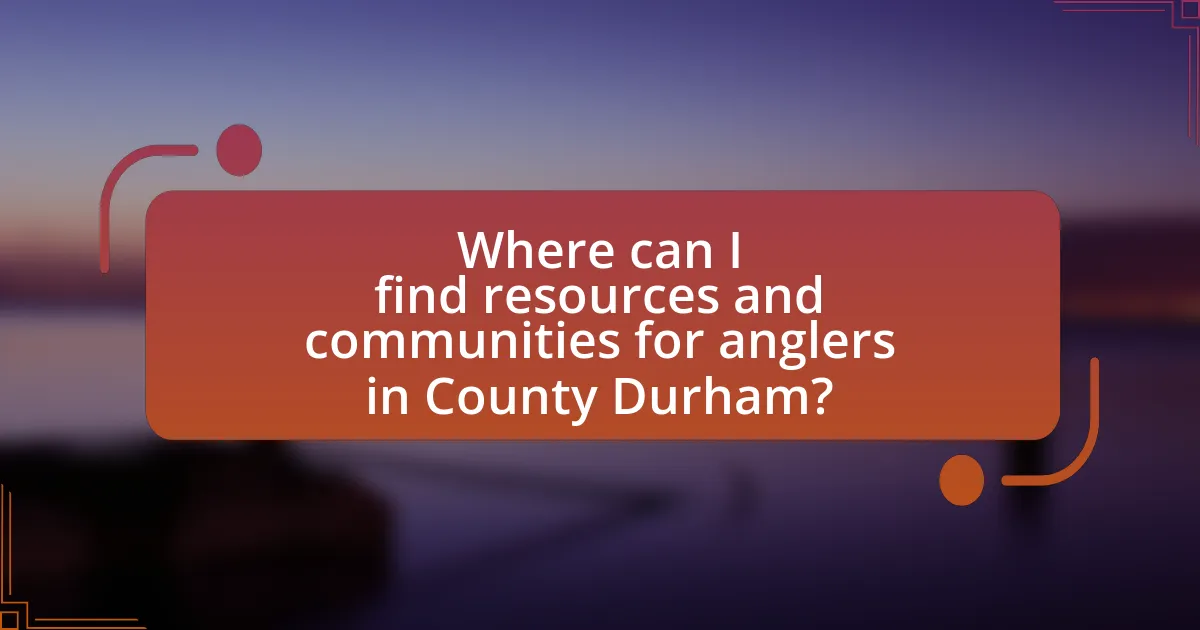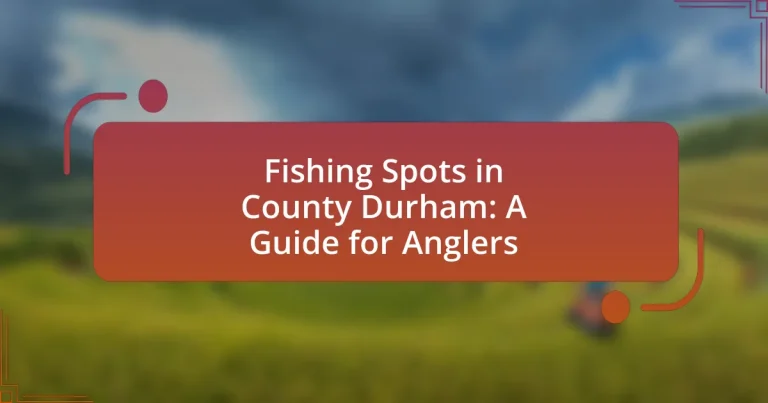Fishing Spots in County Durham: A Guide for Anglers provides a comprehensive overview of the best fishing locations in the region, including the River Wear and River Tees, as well as local reservoirs like Grassholme and Selset. The article outlines how to choose the right fishing spot based on factors such as water type, fish species, and accessibility, while also detailing popular fishing types, including coarse and game fishing. Additionally, it covers essential information on local regulations, fishing licenses, and best practices for responsible fishing, ensuring anglers are well-informed for a successful experience in County Durham’s diverse aquatic environments.

What are the best fishing spots in County Durham?
The best fishing spots in County Durham include the River Wear, which is known for its diverse fish species such as trout and grayling. Another notable location is the River Tees, offering excellent opportunities for coarse fishing. Additionally, the reservoirs like Grassholme Reservoir and Selset Reservoir provide anglers with chances to catch trout in a scenic environment. These locations are recognized for their accessibility and the quality of fishing experiences they offer, making them popular among local and visiting anglers.
How do I choose the right fishing spot in County Durham?
To choose the right fishing spot in County Durham, assess local water bodies such as rivers, lakes, and reservoirs known for specific fish species. Research the River Wear and River Tees, which are popular for trout and coarse fishing, and consider the availability of amenities like access points and parking. Additionally, consult local fishing reports and regulations to identify active fishing areas and seasonal patterns, ensuring compliance with fishing licenses and rules.
What factors should I consider when selecting a fishing location?
When selecting a fishing location, consider water type, fish species, accessibility, regulations, and seasonal patterns. Water type, such as freshwater or saltwater, influences the species available; for example, freshwater lakes in County Durham host species like trout and perch. Accessibility refers to how easily you can reach the location, which affects your fishing experience; locations near roads or parking areas are often more convenient. Regulations, including fishing licenses and specific rules for each site, are crucial to ensure compliance with local laws. Seasonal patterns, such as spawning times and weather conditions, impact fish behavior and availability, making it essential to choose a location based on the time of year.
How does the type of fish influence my choice of fishing spot?
The type of fish significantly influences the choice of fishing spot because different species inhabit specific environments based on factors like water temperature, depth, and habitat structure. For example, trout prefer cold, clear streams and rivers, while bass are often found in warmer, weedy areas of lakes. Understanding these preferences helps anglers select locations that are more likely to yield successful catches, as certain fish are attracted to particular types of cover, such as rocks, vegetation, or submerged structures. This knowledge is essential for maximizing fishing success in diverse environments like those found in County Durham.
What types of fishing are popular in County Durham?
In County Durham, popular types of fishing include coarse fishing, game fishing, and sea fishing. Coarse fishing is prevalent in local rivers and lakes, where anglers target species such as carp, bream, and roach. Game fishing is also significant, particularly in the River Tees, known for its salmon and trout populations. Additionally, sea fishing along the Durham coastline attracts anglers seeking species like cod and whiting. These fishing types are supported by various local clubs and fisheries, which provide access and resources for anglers.
What freshwater species can be found in County Durham’s waters?
County Durham’s waters host a variety of freshwater species, including brown trout, rainbow trout, perch, pike, and roach. These species are commonly found in local rivers, lakes, and reservoirs, making them popular targets for anglers. The presence of these species is supported by local fishing regulations and reports from fishing organizations, which highlight the diversity and abundance of fish in the region’s aquatic ecosystems.
How does the fishing season affect the types of fish available?
The fishing season significantly influences the types of fish available, as different species have specific spawning and feeding patterns that align with seasonal changes. For instance, in County Durham, species such as trout are typically more abundant during the spring and early summer months when water temperatures rise, promoting their activity and feeding. Conversely, species like pike are more prevalent in the colder months, as they are more active in cooler water. This seasonal variation is supported by local fishing regulations that often designate specific open and closed seasons for various species to protect spawning populations, ensuring sustainable fishing practices.
What amenities and facilities are available at fishing spots in County Durham?
Fishing spots in County Durham typically offer amenities such as parking, picnic areas, and restroom facilities. Many locations also provide access to fishing platforms or piers, ensuring convenience for anglers. Specific sites, like the River Wear and various lakes, may feature additional services such as bait shops and equipment rentals, enhancing the fishing experience. These amenities are designed to support both novice and experienced anglers, making fishing more accessible and enjoyable in the region.
Are there any fishing licenses or permits required?
Yes, fishing licenses or permits are required in County Durham. Anglers must obtain a valid Environment Agency rod license to fish in freshwater, which can be purchased online or at designated retailers. Additionally, specific fishing spots may have their own regulations, requiring additional permits or fees, particularly for private waters. Compliance with these regulations ensures sustainable fishing practices and legal adherence.
What facilities can I expect at popular fishing locations?
At popular fishing locations, anglers can expect facilities such as designated fishing areas, accessible parking, restrooms, and sometimes on-site bait shops. Many locations also provide picnic areas, cleaning stations for fish, and seating or benches for comfort. For example, in County Durham, sites like the River Wear and local reservoirs often feature these amenities, enhancing the overall fishing experience.

How can I enhance my fishing experience in County Durham?
To enhance your fishing experience in County Durham, focus on exploring diverse fishing locations such as the River Wear, River Tees, and various lakes like Grassholme Reservoir. These sites offer a range of fish species, including trout and coarse fish, which can improve your catch rate. Additionally, consider using local bait and tackle shops for expert advice on the best techniques and seasonal fishing conditions. Engaging with local fishing clubs can also provide valuable insights and access to exclusive fishing spots.
What local regulations should I be aware of when fishing?
When fishing in County Durham, you should be aware of local regulations that include obtaining a valid fishing license, adhering to specific fishing seasons, and following catch limits for various species. The Environment Agency mandates that anglers must possess a rod license, which can be purchased online or at designated retailers. Additionally, certain waters may have restrictions on the types of bait used and the methods of fishing allowed, such as catch and release policies for specific fish species. Compliance with these regulations is essential to promote sustainable fishing practices and protect local aquatic ecosystems.
How do fishing regulations vary across different locations?
Fishing regulations vary significantly across different locations due to local laws, environmental conditions, and species management practices. For instance, in County Durham, specific regulations may include restrictions on fishing seasons, catch limits, and designated fishing areas, which differ from those in other regions of the UK. The Environment Agency oversees these regulations, ensuring they align with conservation efforts and sustainable fishing practices. Additionally, local councils may impose their own rules, such as requiring permits for certain waters or restricting the use of specific bait. These variations are essential for maintaining fish populations and protecting aquatic ecosystems.
What are the consequences of not following local fishing laws?
Not following local fishing laws can result in significant penalties, including fines, confiscation of fishing gear, and potential criminal charges. For instance, in the UK, anglers caught violating fishing regulations may face fines up to £2,500 for serious offenses, as outlined by the Environment Agency. Additionally, repeated violations can lead to loss of fishing licenses and restrictions on future fishing activities. These laws are in place to protect fish populations and maintain ecological balance, emphasizing the importance of compliance for sustainable fishing practices.
What tips can improve my fishing success in County Durham?
To improve fishing success in County Durham, anglers should focus on understanding local fish species and their habitats. Research indicates that targeting specific species like trout in rivers such as the River Wear and River Tees during their active feeding times, typically early morning and late evening, increases catch rates. Additionally, using locally recommended bait, such as maggots or worms, can enhance effectiveness, as these are known to attract fish in the region. Familiarizing oneself with local regulations and seasonal patterns also contributes to better fishing outcomes, as certain areas may have restrictions or specific peak seasons for different species.
How can I effectively use bait and lures in local waters?
To effectively use bait and lures in local waters, select species-specific bait and lures that mimic the natural prey of the fish in County Durham. For example, using maggots or worms can attract species like roach and perch, while spinners and jigs are effective for targeting pike and trout. Local waters often have specific conditions, such as water temperature and clarity, which influence fish behavior; therefore, adjusting your technique based on these factors can enhance your success. Research indicates that anglers who match their bait to the local forage see a significant increase in catch rates, as fish are more likely to respond to familiar food sources.
What techniques are recommended for different fishing environments?
Different fishing environments require specific techniques to maximize success. In freshwater lakes, anglers should use techniques such as bobber fishing or bottom fishing with live bait, as these methods effectively attract species like bass and trout. In rivers, casting lures or using fly fishing techniques is recommended due to the current, which can influence fish behavior and feeding patterns. For saltwater environments, techniques like trolling or surf casting are effective, as they allow anglers to cover larger areas and target species such as mackerel or flounder. Each technique aligns with the unique characteristics of the fishing environment, enhancing the likelihood of a successful catch.

Where can I find resources and communities for anglers in County Durham?
You can find resources and communities for anglers in County Durham through local fishing clubs, online forums, and social media groups. Notable clubs include the Durham City Angling Club, which offers membership and organizes events, and the North East Angling Association, which provides information on local waters and regulations. Online platforms like Facebook host groups such as “County Durham Anglers,” where members share tips and experiences. Additionally, websites like FishPal provide details on fishing permits and locations in County Durham, enhancing access to fishing resources.
What local fishing clubs or organizations can I join?
In County Durham, you can join several local fishing clubs and organizations, including the Durham Angling Club, which offers access to various waters and organizes competitions. Another option is the Teesdale Angling Association, known for its focus on river fishing and conservation efforts. Additionally, the North East Fly Fishing Club provides opportunities for fly fishing enthusiasts. These clubs typically have membership options that include access to local fishing spots and community events, enhancing the fishing experience in the region.
How can joining a fishing club enhance my skills and knowledge?
Joining a fishing club can significantly enhance your skills and knowledge by providing access to experienced anglers and structured learning opportunities. Clubs often organize workshops, seminars, and hands-on training sessions that cover various fishing techniques, equipment usage, and local fishing regulations. For instance, members can learn about specific fishing spots in County Durham, including the best times to fish and the types of bait that are most effective. Additionally, being part of a community allows for the sharing of tips and experiences, which can lead to improved fishing strategies and increased success on the water.
What events or competitions are held for anglers in County Durham?
County Durham hosts various events and competitions for anglers, including the annual County Durham Angling Association competitions and local fishing festivals. These events typically feature categories for different age groups and skill levels, promoting community engagement and sport fishing. The competitions often take place at popular fishing locations such as the River Wear and various lakes, providing anglers with opportunities to showcase their skills and compete for prizes.
What online resources are available for anglers in County Durham?
Online resources available for anglers in County Durham include the Environment Agency’s website, which provides information on fishing licenses, regulations, and local fishing conditions. Additionally, the County Durham Angling Association offers a dedicated website featuring details on local clubs, events, and fishing venues. Social media platforms, such as Facebook groups focused on fishing in County Durham, also serve as valuable resources for sharing tips, experiences, and updates among local anglers. These platforms collectively enhance the fishing experience by providing essential information and community support.
How can social media groups assist in finding fishing spots?
Social media groups can assist in finding fishing spots by providing real-time information and shared experiences from local anglers. Members often post updates about recent catches, water conditions, and specific locations that are currently productive for fishing. For example, groups dedicated to fishing in County Durham may have discussions about the best times to fish certain rivers or lakes, as well as tips on bait and techniques that are working well. This collective knowledge can significantly enhance an angler’s chances of success by directing them to popular or lesser-known fishing spots based on community feedback and shared insights.
What websites provide up-to-date information on fishing conditions?
Websites that provide up-to-date information on fishing conditions include Fishbrain, which offers real-time data on fishing spots and conditions based on user reports, and the National Oceanic and Atmospheric Administration (NOAA), which provides weather forecasts and marine conditions relevant to fishing. Additionally, local fishing forums and state wildlife agency websites often feature current fishing reports and conditions specific to regions, including County Durham. These sources are reliable as they aggregate user-generated content and official data, ensuring anglers have access to accurate and timely information.
What are some best practices for responsible fishing in County Durham?
Best practices for responsible fishing in County Durham include adhering to local fishing regulations, practicing catch and release, using appropriate tackle to minimize harm to fish, and respecting the natural environment. Local regulations, enforced by the Environment Agency, dictate specific fishing seasons, size limits, and permitted methods to ensure sustainable fish populations. Catch and release practices help maintain fish stocks, particularly for species that are vulnerable or in decline. Using barbless hooks and minimizing the time fish spend out of water reduces stress and injury. Additionally, anglers should avoid littering and should clean up after themselves to protect the habitats of aquatic life. These practices contribute to the conservation of County Durham’s fishing resources and promote a healthy ecosystem.
How can I practice catch and release effectively?
To practice catch and release effectively, use barbless hooks to minimize injury to fish. This technique allows for easier removal of the hook and reduces damage to the fish’s mouth. Additionally, handle fish gently and wet your hands before touching them to protect their slime coating, which is vital for their health. Keep the fish in the water as much as possible during the release process to reduce stress and increase survival rates. Studies show that fish released quickly and with minimal handling have higher survival rates, emphasizing the importance of these practices in catch and release fishing.
What steps can I take to minimize my environmental impact while fishing?
To minimize your environmental impact while fishing, practice catch and release, use biodegradable bait, and avoid fishing in sensitive habitats. Catch and release helps maintain fish populations, as studies show that released fish can survive and reproduce, contributing to ecosystem health. Biodegradable bait reduces pollution and harm to wildlife, as synthetic materials can persist in the environment. Additionally, avoiding sensitive habitats, such as spawning grounds, protects vulnerable species and their ecosystems, ensuring sustainable fishing practices.




